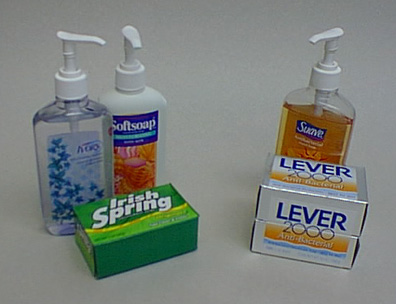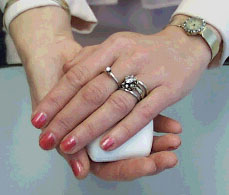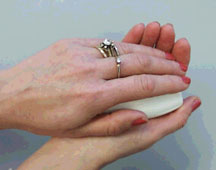|
Methods of
Removing Germs

Mechanical removal of germs.
Handwashing with plain soaps or detergents (in bar, granule or
liquid form) suspends millions of germs and allows them to be
rinsed off. This process removes transient microorganisms. Transient
microorganisms are the germs you pick up from the environment.
Chemical removal of germs
Handwashing with antimicrobial-containing products kills or inhibits
the growth of microorganisms. This process removes both transient
and some resident microorganisms. Resident microorganisms are
a healthy part of normal skin.
Antibacterial
Uh-Oh!
 Many soaps, detergents and
other cleaning products offer antibacterial versions of their
products. While extra bacteria-fighting power may sound like
a good idea, researchers are beginning to disagree. Using antibacterial
products on your body and in your home helps bacteria to build
up resistance to being killed. If the bacteria in your home become
resistant and you get a bacterial infection, the infection will
be harder to cure. Here are some antibacterial tips: Many soaps, detergents and
other cleaning products offer antibacterial versions of their
products. While extra bacteria-fighting power may sound like
a good idea, researchers are beginning to disagree. Using antibacterial
products on your body and in your home helps bacteria to build
up resistance to being killed. If the bacteria in your home become
resistant and you get a bacterial infection, the infection will
be harder to cure. Here are some antibacterial tips:
- Use antibacterial products only if someone in your house
has recently been ill or has had surgery and is especially vulnerable
to infection.
- Use regular soap and hot water to wash your hands with and
regular dishwashing soap for your kitchen.
- Bleach or chlorine-based cleaners are effective for disinfecting
floors, counters and other surfaces. These won't help bacteria
become resistant.
- Be sure to wash all fresh fruits and vegetables to get rid
of any antibiotic that may have been sprayed on them while they
were growing.
- Don't take antibiotics for viral infections, such as the
flu. They won't help the infection go away, and they can encourage
bacterial resistance. If you do take an antibiotic prescribed
by the doctor, finish the prescription, even if you feel better
before the bottle is empty. Never take someone else's prescription!
- Remember to WASH YOUR HANDS!! This is the best way to get
rid of bacteria!
Activities
1. Test Your Handwashing Technique
- Materials needed - Glo Germ oilTM
or vegetable oil and cinnamon, UV light, bars of soap and stop
watch.
- Set out the necessary materials. If using oil and cinnamon,
place a few drops of oil on your hands. Rub hands together to
distribute the oil evenly. Sprinkle cinnamon lightly over the
oiled hands. If you use the Glo Germ oilTM,
rub some over both hands. Shine the UV light on your hands and
notice the glowing germs. Wash your hands. Use the watch
to see how long you wash your hands. Shine the UV light on your
clean hands. How many germs are left?
2. The High Five
To be sure your hands don't carry disease-causing germs, follow
the five basic steps to handwashing. They are as follows:

- Step 1 - Wet hands with
hot water. Add soap.
- Step 2 - Use friction
to work up lather and wash hands for at least 20 seconds.
- Step 3 - Rinse well under
a stream of water.
- Step 4 - Dry hands thoroughly,
with a single-use paper towel whenever possible.
- Step 5 - Turn off faucet
with paper towel, if possible.
Interesting
Questions
1. What about hand lotion?
Answer: One study indicated that wearing
hand lotion increased the bacterial count.
2. What about rings?
Answer: More bacteria were found while
wearing rings than not wearing rings. However, after scrubbing
hands thouroughly, the difference in bacterial count was not
statistically significant. While wearing rings increased the
number of microorganisms on the hands, a thourough handwashing
reduced this number to a count similar to that obtained when
rings were not worn.
3. Which method of drying hands results
in the lowest number of viruses and bacteria getting on hands
after you wash them: cloth, paper towels or air drying with an
electric
blower?
Answer: air drying with an electric
blower produces the lowest and cloth drying the highest in numbers
of both test organisms (viruses and bacteria).
4. How often during the day do you
wash your hands?
Answer: One study indicated that their
employees averaged washing hands just once during the day. Keep
in mind the five times to be especially sure to wash hands.
Summary
 Good handwashing
habits are important when you handle or eat food. Handwashing
removes dirt and harmful germs so that they don't contaminate
the food. There are five times when it is especially important
to wash your hands and five steps to good handwashing.
You can remember this because there are five fingers on your
hand - one for each step! Finally, remember that you don't
have to buy antibacterial soap to kill germs. A thorough
handwashing job using regular soap will kill the germs just as
well! Good handwashing
habits are important when you handle or eat food. Handwashing
removes dirt and harmful germs so that they don't contaminate
the food. There are five times when it is especially important
to wash your hands and five steps to good handwashing.
You can remember this because there are five fingers on your
hand - one for each step! Finally, remember that you don't
have to buy antibacterial soap to kill germs. A thorough
handwashing job using regular soap will kill the germs just as
well!
Web
Site Activities
1. Glo-GermTM website: www.glogerm.com
2. Fight BAC! www.fightbac.org
   [ LESSONS || SITE
MAP || LOCAL AGENTS || RESOURCES || PEOPLE ]
[ LESSONS || SITE
MAP || LOCAL AGENTS || RESOURCES || PEOPLE ]
 Issued in furtherance of Cooperative Extension
work, Acts of Congress of May 8 and June 30, 1914, in cooperation
with the United States Department of Agriculture. The Louisiana
Cooperative Extension Service provides equal opportunities in
programs and employment. Information and Graphics on this site
are copyright protected by LSU Agricultural Center's Louisiana Cooperative Extension Services.
For more information
on the EFNEP program, contact EFNEPMail@agcenter.lsu.edu. Issued in furtherance of Cooperative Extension
work, Acts of Congress of May 8 and June 30, 1914, in cooperation
with the United States Department of Agriculture. The Louisiana
Cooperative Extension Service provides equal opportunities in
programs and employment. Information and Graphics on this site
are copyright protected by LSU Agricultural Center's Louisiana Cooperative Extension Services.
For more information
on the EFNEP program, contact EFNEPMail@agcenter.lsu.edu.
|